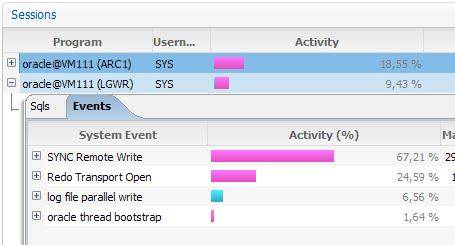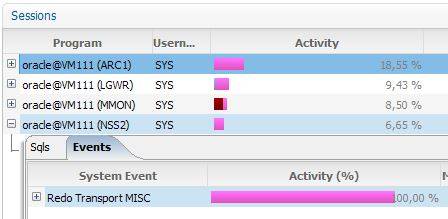By Franck Pachot
.
There are several new features in 12c about Data Guard: cascaded standby, far sync instance. But there are also some architecture changes: new processes and new wait events.
Here is an example of an AWR report of a LogXptMode=’SYNC’ DataGuard configuration in 11g – which means that the log_archive_dest is defined with: ‘LGWR SYNC AFFIRM’
That report comes from a period of time where the primary database was stuck because the standby server had a problem. It’s 11.2.0.2 and the foreground events show that the user sessions are waiting on LGWR:
11g Top 5 Timed Foreground Events
| Event | Waits | Time(s) | Avg wait (ms) | % DB time | Wait Class |
|---|---|---|---|---|---|
| log file sync | 17,002 | 21,113 | 1242 | 46.08 | Commit |
| log buffer space | 1,322 | 8,583 | 6493 | 18.73 | Configuration |
| buffer busy waits | 1,869 | 4,376 | 2342 | 9.55 | Concurrency |
| enq: TX – row lock contention | 997 | 2,105 | 2111 | 4.59 | Application |
| DB CPU | 1,773 | 3.87 |
then we have to go to the background event section in order to see what the LGWR was waiting on:
Background Wait Events
| Event | Waits | %Time -outs | Total Wait Time (s) | Avg wait (ms) | Waits /txn | % bg time |
|---|---|---|---|---|---|---|
| LNS wait on SENDREQ | 17,674 | 0 | 2,103 | 119 | 1.04 | 37.50 |
| LGWR-LNS wait on channel | 153,447 | 88 | 2,094 | 14 | 9.03 | 37.34 |
| log buffer space | 17 | 0 | 114 | 6723 | 0.00 | 2.04 |
| db file parallel write | 52,931 | 0 | 105 | 2 | 3.12 | 1.87 |
| enq: CF – contention | 16 | 0 | 78 | 4865 | 0.00 | 1.39 |
| log file switch completion | 4 | 0 | 63 | 15640 | 0.00 | 1.12 |
| log file sync | 6 | 0 | 55 | 9102 | 0.00 | 0.9 |
In 11g the LNS processes (Log Network Server) is responsible to send redo to the standby.
Because we are in SYNC we wait for remote acknowlegement.
Nothing new here. But let’s see what has changed in 12c.
12c
In 12c the name of the processes have changed. It’s not LNS anymore, but:
- NSS ships the redo from LGWR to remote standby when we are in SYNC
- NSA ships the redo from online redo logs to standby when we are in ASYNC
and you will see new wait events for them:
- ‘SYNC Remote Write’ for all redo transport waits done by NSS processes
- ‘ASYNC Remote Write’ for all redo tranport waits done by NSA processes
SYNC Remote Write
So what is the 12c equivalent of the following waits that are symptomatic of SYNC latency:
- LGWR waiting on LNS – wait event ‘LGWR-LNS wait on channel’
- LNS waiting on standby – wait event ‘LNS wait on SENDREQ’
Here they are in picture (using Orachrome Lighty):
- The LGWR is waiting on NSS – wait event is ‘SYNC Remote Write’:
- NSS is waiting on redo transport:
If you were monitoring for ‘LNS’ wait events, you have to change it.
Here is the new pattern in an AWR report:
| Event | Waits | %Time -outs | Total Wait Time (s) | Avg wait (ms) | Waits /txn | % bg time |
|---|---|---|---|---|---|---|
| log buffer space | 7 | 0 | 896 | 128023.85 | 0.00 | 58.96 |
| SYNC Remote Write | 129 | 0 | 300 | 2322.96 | 0.00 | 19.72 |
| buffer busy waits | 2 | 0 | 287 | 143596.94 | 0.00 | 18.89 |
| log file parallel write | 116 | 0 | 6 | 48.02 | 0.00 | 0.37 |
| Data Guard Broker Wait | 5 | 100 | 5 | 1000.26 | 0.00 | 0.33 |
| Redo Transport MISC | 110 | 0 | 2 | 22.70 | 0.00 | 0.16 |
The documentation is not yet up-to-date, but all the old and new wait events are documented here.


![Thumbnail [60x60]](https://www.dbi-services.com/blog/wp-content/uploads/2022/12/oracle-square.png)
![Thumbnail [90x90]](https://www.dbi-services.com/blog/wp-content/uploads/2022/08/DWE_web-min-scaled.jpg)
![Thumbnail [90x90]](https://www.dbi-services.com/blog/wp-content/uploads/2022/08/JDU_web-min-scaled.jpg)